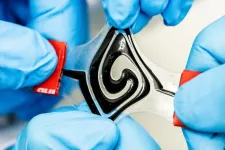(Press-News.org) New research to be presented at this year’s European Congress on Obesity (ECO 2025, Malaga, Spain, 11-14 May) shows that around two thirds of participants of the SURMOUNT-1 trial had only regained 5% or less of their so-called nadir (or lowest weight) three years after beginning treatment with tirzepatide. The study is by Professor Louis Aronne, Comprehensive Weight Control Center, Division of Endocrinology, Diabetes, and Metabolism, Weill Cornell Medicine, New York, NY, USA, and co-authors from Eli Lilly and Company, Indianapolis, IN, USA, which funded the study.
Obesity management is a long-term journey during which fluctuations in body weight are expected to occur. For some patients, a previous nadir (or lowest) weight can become a point of focus (and disappointment when it cannot be reached again). However, there is not yet clear literature that nadir weight is clinically relevant. This post hoc analysis of the SURMOUNT-1 study, at 3 years, aimed to assess weight regain from nadir weight over 3 years (36 months / 176 weeks) with tirzepatide treatment.
The original SURMOUNT-1 trial was published in NEJM in 2022, and found that, across 72 weeks, participants with obesity treated with 5 mg, 10 mg, or 15 mg of tirzepatide once weekly experienced substantial and sustained reductions in body weight.
This analysis included 690 tirzepatide-adherent participants (65% female, 35% male) with a mean age of 49 years, a mean weight of 107 kg, and a mean BMI of 38.6 kg/m2 who were chosen from the original SURMOUNT-1 cohort on the basis they had been treatment-adherent across the 3-years (with 75% or more of planned doses received) and were living with obesity(a BMI of at least 30 kg/m²), or overweight (a BMI of at least 27 kg/m²) and prediabetes, and had been participants in the SURMOUNT-1 study and had lost at least 5% of their baseline weight when reaching their nadir weight (the lowest weight achieved during treatment).
Weight regain from nadir to Week 176 was defined as the difference between percent weight reduction from baseline to nadir and percent weight reduction from baseline to Week 176. Weight regain analyses were calculated as a mean across groups and were categorised as less than 5%, 5% to 10%, and 10% or more weight regain.
The analysis showed that the mean time to nadir weight was 22 months (96 weeks). The mean percent weight reduction at nadir weight was 23.1%. The mean percent weight regain from nadir weight to Week 176 was 3.7%, meaning that across the 690 participants over these three years there was a mean percent weight reduction of 19.4% (23.1% minus 3.7%).
At Week 176, 73%, 19%, and 8% of participants treated with tirzepatide 5 mg (227 participants) regained less than 5%, 5% to 10%, and 10% or more from nadir weight, respectively. Similarly, 65%, 26%, and 9% of participants treated with tirzepatide 10 mg (N=239) regained less than 5%, 5% to 10%, and 10% or more weight from nadir to week 176, respectively. Among participants treated with tirzepatide 15 mg (N=224), 73%, 20%, and 7% experienced less than 5%, 5% to 10%, and 10% or more weight regain from nadir to Week 176, respectively.
The authors have not yet analysed if there are any differences in weight gain between men and women or between older and younger participants.
Dr Aronne concludes: “This analysis found that 70% of participants treated with tirzepatide had limited weight regain – meaning 5% or less - after their nadir, or lowest weight. Less than 10% of participants regained 10% or more from their nadir weight. Overall, these findings suggest that most participants receiving tirzepatide had a relatively stable weight journey over 3 years in the SURMOUNT-1 3-year study, and managed to avoid any substantial weight regain.”
END
3-year study of tirzepatide shows that most patients only gain 5% or less from their lowest or ‘nadir’ weight
2025-04-11
ELSE PRESS RELEASES FROM THIS DATE:
Tirzepatide can produce clinically meaningful weight loss for at least 3 years in adults with overweight or obesity who don’t have diabetes
2025-04-11
Once-weekly treatment with tirzepatide can produce clinically meaningful and sustained weight loss for at least 3 years in adults with overweight or obesity who do not have diabetes, according to new research being presented at this year’s European Congress on Obesity (ECO) in Malaga, Spain (11-14 May). The findings also indicate that females and those without obesity-related complications may be more responsive to tirzepatide treatment.
The study, led by Dr Luca Busetto from the University of Padova in Italy and colleagues from Eli Lilly and Company that manufacture tirzepatide, is a continuation of the SURMOUNT-1 phase 3 trial of tirzepatide, a medication approved in ...
Common respiratory condition nearly triples the risk of death in adults, new study finds
2025-04-11
Common respiratory condition nearly triples the risk of death in adults, new study finds
A major study presented today at ESCMID Global 2025 has revealed that adults with respiratory syncytial virus-associated acute respiratory infection (RSV-ARI) face a 2.7-fold higher risk of death within one year compared to the general population.1
The findings underscore the significant, yet often under-recognised, long-term health and economic burden of RSV-ARI in adults, particularly among those with underlying conditions such as chronic obstructive pulmonary disease (COPD) and asthma.
RSV-ARI refers ...
New research shows evidence of children’s gender biases reflected in their facial emotional expressions
2025-04-11
New research recently published in Archives of Sexual Behavior suggests children’s gender biases can be reflected in their facial emotional expressions.
Psychology professor Doug VanderLaan and his colleagues at the University of Toronto Mississauga, studied 296 children (148 boys and 148 girls) in Canada between the ages of four and nine years old while Wang Ivy Wong, Karen Kwan and their colleagues at the Chinese University of Hong Kong, and The Hong Kong Polytechnic University studied 309 children (155 boys and 154 girls) in Hong Kong. All children watched four short stories that included five illustrations with pre-recorded audio narratives. ...
Crustal brines at an oceanic transform fault
2025-04-11
Woods Hole, Mass. (April 11, 2025) - Being a geophysicist can sometimes feel like being a detective —uncovering clues, and then building a case based on the evidence.
In a new article published in Science Advances, a collaborative team led by the Woods Hole Oceanographic Institution (WHOI), presents a never-before-seen image of an oceanic transform fault from electromagnetic (EM) data collected at the Gofar fault in the eastern Pacific Ocean. The National Science Foundation funded work reveals ...
The Journal of Nuclear Medicine Ahead-of-Print Tip Sheet: April 11, 2025
2025-04-11
Reston, VA (April 11, 2025)—New research has been published ahead-of-print by The Journal of Nuclear Medicine (JNM). JNM is published by the Society of Nuclear Medicine and Molecular Imaging, an international scientific and medical organization dedicated to advancing nuclear medicine, molecular imaging, and theranostics—precision medicine that allows diagnosis and treatment to be tailored to individual patients in order to achieve the best possible outcomes.
Summaries of the newly published research articles are provided below.
Tracing Prostate Cancer Beyond the Usual Path
Researchers uncovered ...
A fluid battery that can take any shape
2025-04-11
Using electrodes in a fluid form, researchers at Linköping University have developed a battery that can take any shape. This soft and conformable battery can be integrated into future technology in a completely new way. Their study has been published in the journal Science Advances.
“The texture is a bit like toothpaste. The material can, for instance, be used in a 3D printer to shape the battery as you please. This opens up for a new type of technology,” says Aiman Rahmanudin, assistant professor at Linköping University.
It is estimated that more than a trillion gadgets will be connected to the Internet in ten years’ time. In addition to traditional ...
Light that spirals like a nautilus shell
2025-04-11
Beams of light that can be guided into corkscrew-like shapes called optical vortices are used today in a range of applications. Pushing the limits of structured light, Harvard applied physicists in the John A. Paulson School of Engineering and Applied Sciences (SEAS) report a new type of optical vortex beam that not only twists as it travels but also changes in different parts at different rates to create unique patterns. The way the light behaves resembles spiral shapes common in nature.
The ...
Transforming doors into gateways to the virtual world: the future of mixed reality!
2025-04-11
Ikoma, Japan—People seeking to feel fully immersed in virtual environments will soon be able to experience a revolutionary approach to spatial computing that bridges the gap between real and digital worlds. A collaborative research team from NTT DOCOMO, Inc. and Nara Institute of Science and Technology (NAIST), Japan, has developed a novel mixed reality (MR) technology that transforms how users interact with virtual spaces by using everyday real-world doors as natural transition points.
Virtual reality (VR) and MR technologies have ...
AACR announces recipients of the 2025 AACR June L. Biedler Prize for Cancer Journalism
2025-04-11
PHILADELPHIA – The American Association for Cancer Research (AACR) is pleased to announce the recipients of the 2025 AACR June L. Biedler Prize for Cancer Journalism in the following categories:
Magazine
“Targeting Cancer, Sparing Patients”
By Jyoti S. Madhusoodanan (Photo), Scientific American
Newspaper
“Fighting stigma, fighting cancer: The rising threat of male breast cancer in Kenya”
By Pauline Ongaji Ogada (Photo), Nation
Online/Multimedia
“Farewell, my stomach”
By Teresa Firmino (Photo) and Joana Martins Gonçalves (Photo), Publico
“Women ...
Human-AI relationships pose ethical issues, psychologists say
2025-04-11
It’s becoming increasingly commonplace for people to develop intimate, long-term relationships with artificial intelligence (AI) technologies. At their extreme, people have “married” their AI companions in non-legally binding ceremonies, and at least two people have killed themselves following AI chatbot advice. In an opinion paper publishing April 11 in the Cell Press journal Trends in Cognitive Sciences, psychologists explore ethical issues associated with human-AI relationships, including their potential to disrupt human-human relationships and give harmful advice.
“The ...



